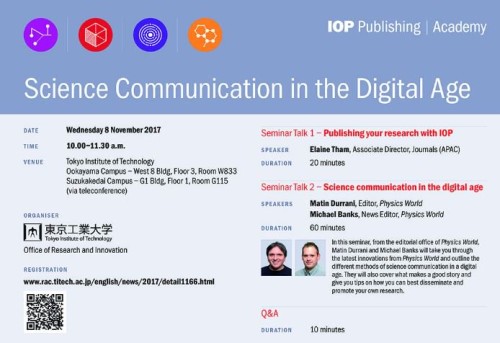By Matin Durrani in Tokyo, Japan
For physicists, doing research is only the start of the game. With thousands of papers published each year, how do you make sure your latest work stands out from the crowd?
If you’re an established academic, your peers will already know who you are and, provided you can continue getting your papers published in the top journals, your career will carry on hitting the high notes . But if you’re less experienced in the research game, then a good dose of publicity in the mainstream media can give you a great head start – and thankfully the online world can help hugely.
That was the message of a seminar “Science communication in the digital age” given today at Tokyo Institute of Technology by me and my IOP Publishing colleagues Michael Banks (Physics World news editor) and Elaine Tham (associate director for Asia-Pacific). Attended by about 40 students, science communicators and university administrators, the seminar was opened by the president of Tokyo Tech Yoshinao Mishima.
One traditional measure of how well your paper is doing is to note how many times it’s been cited in the reference lists of other papers. But as Elaine pointed out, the digital world offers much more than conventional citation counts. One particularly useful service, now available on all IOP Publishing papers, is Altmetrics.
It captures, in real time, how often a paper has been mentioned by news outlets, policy documents, blogs and other social networks, as well as by other scholarly and non-scholarly sources. By checking your Altmetrics score, which is listed next to the online version of the paper, you can find out what impact your work is having in the wider world.
That’s all very well, I hear you say, but how do you get your work noticed in the first place? There’s no magic solution, of course, but Michael and I offered delegates at Tokyo Tech some top tips for how to get your work spotted and picked up.
Some things are obvious and require little effort: writing about your research on a personal or group website; talking to friends and colleagues; or sending a copy of your paper to those in your field. Others need a bit more work, such as setting up a blog, press-releasing your research, contacting science journalists with story ideas, or creating a short “video abstract” about your paper.
But if you can’t be bothered with any of that, why not just get active on social media? A great photo with a link to your paper can work wonders, especially on Twitter, which academics just love. And best of all it’s free, so you’ve really no excuse.

Guidelines
Show/hide formatting guidelines
this text was deletedwhere people live in harmony with nature and animals</q>
Some text